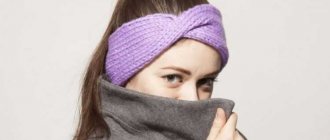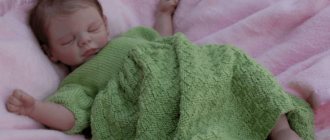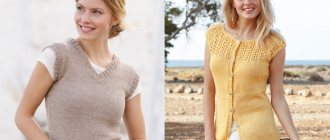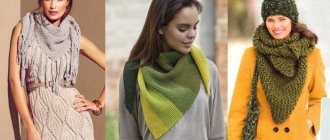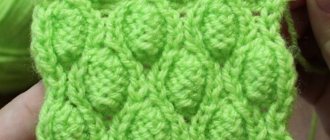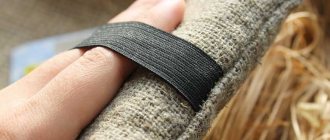Soft, warm, cozy slippers, knitted with your own hands - what could be better for relaxing at home? Having chosen a nice model for yourself, decided on the color and texture of the yarn, and spending very little time, you can please yourself with a wonderful new thing. Knitting slippers for beginner knitters is quite an accessible idea, because there are a huge number of easy-to-make patterns. And for more experienced craftswomen, our selection presents more complex slipper options.
Knitted felt slippers
Sizes: 35-37; 38-40; 41-43. Foot length: 22; 24; 27cm. We will need:
- yarn containing 65% wool, 35% alpaca (50g per 100m) - 100g for any size;
- straight knitting needles No. 4;
- set of double needles No. 4;
- aux. spoke.
Patterns:
- garter pattern: when knitting forward/reverse, we alternate a row of faces. p. with a row of purls; when knitting in the round - all stitches in all rows. – facial;
- arans: see diagrams.
Master class (MK) for beginners on decreases:
- if it is indicated to make decreases by 1p. on each side, then they must be performed strictly from the front side;
- We perform decreases at the beginning of the row by broaching: remove 1 stitch. knit, knit the next one and pull it into the removed one;
- Decrease at the end of the row: knit 2 stitches. in 1 front.
Knitting slippers: master class with description for beginners
We knit in straight/back rows from the middle of the heel to the instep. We knit the visor separately. Then both parts are connected and knitted in a circle to the desired size.
Master class on knitting heels
We cast on with knitting needles No. 4 45; 47; 49p. and make a scarf pattern. At 6; 7; Decrease 10cm of height by 1p. on each side (see MK above). We repeat the decreases every 4th row. 6 times for all sizes. and then in every 2nd r. 3 more; 3; 2 times. We end up with 27 knitting needles; 29; 33p. We complete this stage of knitting by performing 1p. knit stitches from the wrong side. Our slippers have a height of 12; 13; 15cm. We put off knitting.
Visor - master class for beginners
Using knitting needles No. 4, cast on 15; 15; 18p. and knit two rows. Next R. The distribution scheme for items is as follows (front side): 3; 3; 4 knits., *from 1 p. tie 2p.* between *-*repeat three times. Complete row 3; 3; 4 faces There are 21 knitting needles in total; 21; 24p. For the next purl row, the stitch distribution scheme is as follows: 3;3; 4 faces., 6 i., 3; 3; 4 persons 6i., 3; 3; 4 persons Next we knit slippers according to cx. A.1 Having knitted one repeat of pattern A.1, we return the previously connected elements to work and knit slippers with knitting needles in the round.
Sock – master class for beginners
We have 48 on our knitting needles after transferring; 50; 57p. We start with the visor and then the pattern of diagram A. 1. Using the MK and the instructions above, we knit the sock to the desired size. In the first r. We knit the outermost stitches in 2 stitches. in 1p., i.e. in total we subtract 2p. Between them is garter stitch. Next we will knit the slippers in the round: on the instep we perform the pattern of diagram A.1, the remaining stitches are a shawl pattern.
During the knitting process we make decreases: in every 6th p. on both sides of Figure A.1 we reduce 1 p.
For beginning knitters, a row of aran weaves can serve as a guide for decreases. We repeat 6 decreases in total; 7; 8 times.
Simultaneously for 20; 22; 25 cm of height (measured from the cast-on row of the heel) decrease by 1 point. on each section of the scarf pattern in diagram A.1. Our master class clarifies: these will be only three decreases in a row.
We repeat the decreases according to this MK after another 1 cm. As a result, we have 30 on the knitting needles; thirty; 35p. Track. row we will knit with decreases. MK alternation: a series of decreases/a series of purl stitches. A series of decreases: we knit all stitches in 2 stitches. in 1p. After that - 1 rub. purl sts. In next. R. again we make decreases: 2 p. knit together in 1 p. Again we do 1p. purl p. Break the thread, thread it through the remaining loops, and tighten. We perform a heel seam.
We knit the second slipper using knitting needles using the same master class.
Felting - master class
To make our knitted slippers denser and look like felt ones, let's do felting. MK emphasizes: under no circumstances use bleaching agents or enzymes in the process. We put the knitted slippers in the washing machine and start the wash at 40 degrees. The speed is normal, pre-wash is not needed. We put still wet slippers on our feet to give them shape. So we finish drying it. In the future, when washing, we use the mode for woolen products.
Jacquard slippers
Sizes: 35-37; 38-40; 41-43. We will need:
- yarn, consisting of 65% wool, 35% alpaca (50g per 75m), yellow – 50g;
- same, white – 50g;
- set of double needles No. 4;
- circular knitting needles No. 4.
Patterns:
- persons Ch.: in circular knitting, all stitches in all r. – facial; When knitting forward/reverse, we alternate a row of faces. p. with a row of purls;
- jacquard pattern - see diagrams.
Density: face. Ch. 18p. for 23r. equal to 10 cm by 10 cm.
Master class on knitting the original ring
We begin work by knitting a special ring. It must be done carefully so that there is no hole. We hold the end of the thread in our left hand and wrap it around the thread. finger clockwise to form a ring. Leave the thread with a fairly long end. Next *hold large and point. fingers our ring, insert the knitting needle into it. Yarn over with a working thread and pull it through the ring. We received 1p.
Without entering the right sp. into the ring, yarn over it and pull it through the previous p.T.O. we fix this point.* We repeat the algorithm from * to * until we get 12 points. We distribute them on stocking joints. and knit according to the description. The ring must be tightened by pulling the end of the thread.
Description of knitting slippers
Having tied the ring, we continue along cx. A.1. At the end we have 32; 36; 40p. We remove the initial 15; 17; 19p. on aux. sp. This will be the sole. Let's go to sp. No.4 and knit hosiery with yellow yarn. viscous on the remaining 17; 19; 21p. This will be the top part. Closed P.
We dial 17; 19; 21p. on the sp. No4 double yellow yarn. Next we knit in one thread. Tying 4p. persons ch., go to chul. knitting needles and return with auxiliary. knitting needles and loops to work. We have 32; 36; 40p. We continue in a circle and at the same time make decreases along cx. A.2 At the end we have 16; 20; 20p. Closed P.
Sew the heel. We overlap the top part over the edge of the back part (see photo No. 3) and sew the edge of the slipper.
A simple method of knitting slippers
The simplest method is considered to be knitting socks with one seam, which is located along the back wall of the foot, that is, on the heel. Let's consider this method.
You need to prepare yarn, either wool or half-woolen for winter slippers and cotton for the warm season. You will also need knitting needles and a hook. Knitting needles need to be chosen in diameter equal to the diameter of the yarn threads. You also need a centimeter and scissors.
First you need to cast on the loops. For example, for a thirty-eight foot size you will need 31 loops. Having cast thirty-one loops, you need to mark loop 24 in the count. After this loop there are loops for the toes. Rows of knitting should be done with knit stitches.
While knitting, make every fourth row short, without knitting them to the toes. You need to turn the knitting to the side, and so that there are no holes left in these places, you need to tie the first loop with yarn and tighten it tightly.
We recommend reading:
- Knitting a pullover with knitting needles - methods and step-by-step instructions on how to knit a sweater with your own hands (120 photos)
How to knit a heel: the best ways to knit a heel with your own hands quickly and easily (115 photos)
How to knit raglan - description of patterns on how to knit correctly for beginners (110 photos and video master class)
Nine centimeters from the start of work along the large edge, you need to close 16 loops and continue working for another three centimeters. Then in the purl row you should cast on another 16 stitches, but at the end of the row.
After this, you need to continue the garter knitting method for another 9 centimeters. After the work has been done, you need to close all the loops, but do not tighten them.
The finger loops that remain on the edge need to be transferred to the thread and tightened, and the thread itself should be hidden inside the sock.
After the work has been done, you need to take the knitted trace, fold the long side in half and make a seam on this side.
You need to do the same for the second slipper.
Openwork slippers
This very cute pattern will be of interest especially to experienced knitters. Its main highlight is its non-standard knitting principle: we start from the toe with a ring of threads. How to knit a ring - see the previous model. We put the required number of stitches into it. Having knitted the open part, we switch to knitting in rows.
Sole length: 22; 24; 27cm. We will need:
- yarn containing 65% wool, 35% alpaca (50g per 75m) – 50; 100; 100g;
- set of double needles No. 4;
- markers (M).
Pattern:
- is carried out according to the scheme.
Master class on knitting slippers
We make a ring from threads and knit according to pattern A.1. For each size, MK provides a separate diagram. After all the scheme increases we have 36; 40; 44p. At 22; 26; 29 rub. closed circuits 1p. (see diagram). Then we knit until the end of the r. We have 34; 38; 42p. We continue according to the instructions of MK: we knit the initial 17; 19; 21p. along cx (indicated by an arrow), turn the work and continue in rows until cx is completed. A.1.
Let's move on to cx. A.2. For her we dial 15; 15; 17p. double thread - this will be the upper part of the heel. Total 36; 40; 44p. Next we knit with single yarn. We knit 11; 13; 14 faces, put M. We continue according to the scheme. At the end of the vertical rapport in work 16; 20; 24p. Closed n. Sew down the heel.
Simple slippers for beginners
Slipper sizes: 35-37; 38-39; 40-42. Foot length: 22; 24; 26cm. We will need:
- yarn containing 65% wool, 35% alpaca (100g per 96m) - 100g for any size;
- set of toe knitting needles No. 6;
- markers.
Patterns:
- garter stitch: for knitting in the round, alternate 1 p. facial stitches with 1 p. purl; for forward/reverse knitting all stitches in all rows. – facial;
- Braid patterns - see diagram A.1 and diagram A.2.
Density: on a scarf pattern 13p. for 26 rub. equal to 10 cm by 10 cm.
Master class for beginners on knitting slippers
Left slipper
Cast on with knitting needles 36; 38; 40p. and knit in the round with a 4cm scarf stitch. We finish with a row of purl stitches. Then we knit only the initial 11; 13; 13p., remaining 25; 25; 27p. we shoot on additional knitting needle
We continue, including 2 stitches in this row. on each side with additional knitting needles: 1 knit, scarf. pattern, 13; 15; 15p. - pattern according to cx. A.1, 1 kr., scarf. drawing. We have 15; 17; 17p. We continue to knit the pattern in microns until the height reaches 6.5; 8; 9.5 cm. We adjust so that the last row is purl-sided. We knit with knitting needles 1p. persons p., performing decreases 4p. at regular intervals. 11 remain; 13; 13p.
We continue with straight and reverse rows, using a master class for beginners and pattern diagrams. Open from 11:13; 13p. central part, plus raise the loops at the end of the river. with additional knitting needles The first time we raise 12; 14; 16p. We unfold the work and knit a row. At the end of the river raise 12 again; 14; 16p. We have 60 in operation; 66; 72p.
We will now measure the slippers from this place. Place one marker in the center of the top of the foot, the second in the center of the heel loops. Knit a scarf pattern at 2cm height. Next, decrease by 1 p. on both sides near each marker. We make decreases by knitting 2 stitches with knitting needles. together facial. Thus, for one row we subtract 4 points. We continue knitting with decreases until height 5; 5; 6cm product height. Closed P.
Right slipper
Knitting repeats the previous master class. The difference is in the direction of the “Spit” on the central part. For this slipper, scheme A.2 is used.
Assembly
Sew the seams on the sole.
Slippers in the shape of ballet shoes with embroidery
Ballet flats or slippers are the model that best suits pajamas and tracksuits. They do them as follows:
- Cast on 34 loops.
- Remove the edge and knit 32 liters.
- In the second row, having removed the edge, knit 10 l, purl 1, repeat the pattern.
- The third row is knitted like the first, the fourth like the second.
- For size 39 slippers, you should knit a total of 22 cm (RUR 65-70)
- Having reached the middle of the canvas, you need to change the pattern of the pattern.
Finger extension
To be comfortable in slippers, they should not limit the flexibility and mobility of the foot. You need to add a few loops:
- The first row of the bow part of the leotka is knitted in this way - edge, then 11 l., increase (from 1 p. two 2), 8 l., increase again., 11 l. Repeat the sequence.
- The second consists of an edge, 10 l., 1 p., 12 l., 1 p., 10 l., a second edge.
- The third row consists of 2 edge rows, 34 l. This and the previous one are then alternated.
- The last couple of centimeters of the fabric must be knitted with a 1x1 elastic band.
- The loops are not closed, they are strung on the remaining thread and pulled together. The edges of the product are carefully sewn to 8-9 cm or tied with an invisible seam using a hook.
Connecting parts and decorating
The canvas is ultimately divided into three sectors by a pattern. It is very convenient and practical. The pattern can be completely different, just the way you want. But with this separation, all the parts are sewn together faster.
This is done like this:
- on the heel, the central strip must be pulled together with thread;
- Sew the other two parts with a needle or tie with an invisible seam using a hook.
The slipper is ready. All that remains is to decorate it with appliqués, embroidery, pompoms, beads, ribbons, and sew on insoles.
The indisputable advantage of knitted slippers is that they do not clutter up the shoe shelf in the hallway, easily fit in the closet, and can be washed in an automatic washing machine. You can knit any of the listed models quite quickly. The work usually takes from a couple of days to several weeks.


